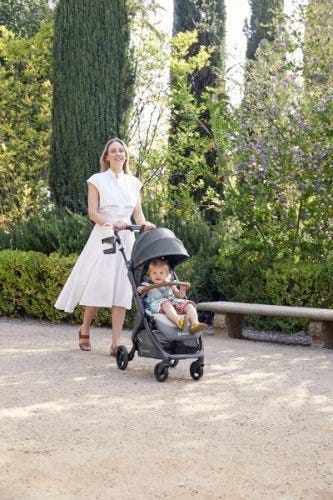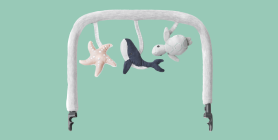
As babywearing parents and carrying educators, researchers, and enthusiasts, I’m sure we all share the belief that everyone should be able to wear their baby. You only need to feel the magic of “sleepy dust” with your own baby, or see the joy of a caregiver successfully wrapping their baby for the first time to understand that this practice is important.
And that a well-used carrier is much more than just another baby gear product on a registry. But let’s face it: high quality carriers are out of the price range for many new parents. Thanks to lending libraries, secondhand sales, and hand-me-down gifts, often the “village” surrounding the new parent will ensure that the price tag alone isn’t prohibitive.
But that’s not the only barrier. Whether parents can afford a carrier or not, fully embracing this practice is not just an issue of economic access. It’s all about cultural access. Being able to fully adopt babywearing as an integral component of a caregiving strategy depends on more than just access to the tool itself. It requires respect for the original cultures of carrying around the world and across human history. It requires cultural norms and policies that make carrying easily integrated into modern life. And it requires cultural attitudes and beliefs that understand carrying to be a valuable postpartum health intervention.
Respect for Babywearing’s Rich History & Culture
A culture of support around babywearing has been woven into the history of humans since the earliest records of our species. It is believed that wraps and slings to support the hands-free transport of our heavy, large-brained, unusually dependent human babies was one of the factors supporting the success of early hominids. Globally, the tools used to carry babies have taken on different variations in function, aesthetics, and cultural meaning depending on the local environmental and cultural context.
All About Baby Carriers for Nature Adventures
These tools have been passed down for generations, maintaining a critical role in how humans have been able to not only survive, but to thrive, even with the energy-intensive demands of caring for a young infant. But although babywearing is a quintessential part of being human and has a rich cultural history around the world, global oppression and imperialism has led to the attempted erasure of this practice in many contexts.
Much like breast/chestfeeding, Western science (and culture!) is now finally catching up to what indigenous communities have known all along: the practice of carrying/wearing your baby holds ample and unique benefits for both infant and parent. This has led to a resurgence of babywearing among industrialized communities. Yet as this practice pops up in new carrying trends, designs, and regulations, it often comes with either a lack of understanding of the cultural significance or the outright appropriation of the cultural importance.
Cultural Norms that Support Babywearing
As we acknowledge this harmful history of the oppression of indigenous, global majority parenting practices, it’s critical that present-day carrying is not only honoring the historical and cultural roots of babywearing, but that it is equitably accessible to the original holders of this practice. Unfortunately, that is not the case.
The immediate postpartum period and first year of an infant’s life – when the benefits of babywearing are most pronounced for both parent and infant – is characterized in industrialized countries by parent-infant separation, especially in the US. Even if a parent did have the cultural understanding and economic access to be able to wear their baby, the lack of mandated paid leave in the United States and lack of equitable access to either paid leave and/or babies-at-work policies make this practice inaccessible.
Exploring Nature with a Baby Carrier
Understanding of Carrying as an Essential Postpartum Health Intervention
Our research has shown that babywearing is not a “nice to have” or even just a smart parenting hack to facilitate cry-free trips to Target. This practice is a necessity for the health of both parent and baby.The randomized controlled trial conducted by myself and colleagues at Nurturely, Healthy Start San Diego, and our academic collaborators, showed that babywearing reduces symptoms of postpartum depression, one of the most common complications of childbirth around the world. We have also published research showing that babywearing increases lactation. Given that most parents want to feed their baby human milk, yet the majority of parents are forced to stop breast/chestfeeding earlier than desired, this is an important intervention to improve the health of both infant and the lactating parent.


Advantages of Using Strollers for Nature Adventures


While baby carriers are fantastic for mobility and closeness, depending on the adventure of choice you might want to be a stroller along too.
There are a LOT of baby stroller options on the market. So we understand how confusing it can be to choose the one that’s right for your family. Not only are there a variety of brands, but a variety of strollers that serve different purposes.
There are a few types of strollers on the market:
- Full-sized stroller: This is typically the stroller parents thing of buying for all its versatility.
- Lightweight or umbrella stroller:These compact strollers are perfect for on-the-go adventures.
- Jogging stroller: Designed for parents who want to combine fitness with outdoor adventures.
- Double stroller: Designed for parents with multiple kids, especially twins.
- Car seat carrier: These strollers connect to a specific car seat. We don't typically recommend these as they can be unsafe for baby and uncomfortable for parents who are pushing.
Learn more about the types of strollers and which one would be best for you.
Take Action
#CarryABabyChangeTheWorld is one of our favorite hashtags that we created at Nurturely. We are embodying this mantra by using research, education, and cultural change to ensure all caregivers have access to the science (and magic!) of wearing your baby. This includes a culturally-rooted self-paced infant carrying course for healthcare providers and community health practitioners. At the Nurturely Lounge in Eugene, Oregon, we provide free carrying consults as well as fun programs that introduce carrying to our multicultural community in an inclusive way, including our bilingual Babywearing y Bailando meetup.
We also help community leaders set up free or low-cost carrier rental programs in their community with our CarrierX exchange program. And we are continuing to conduct research to document the ways that carrying can help close racial equity gaps in postpartum health. Do you believe carrying a baby can change the world? Join our campaign to spread the babywearing love and help Nurturely make this practice accessible to all families.
Sign up to be a #CarryaBabyChangetheWorld Campaign Leader by emailing condrea@nurturely.org Don’t want to be a leader but still want to support the campaign? Sign up for the Nurturely email list HERE to be the first to know about campaign launch and how your donation can get you exclusive Carry A Baby Change the World merch while making a direct impact on families through equitable access to babywearing research, education, and cultural support. Thank you for helping carry our mission forward and for introducing Nurturely to your network of friends, family, neighbors and beyond!
-- About the Author: Emily Little, PhD, is a perinatal health researcher and advocate, as well as the Founder and Executive Director of Nurturely, a social impact organization that prevents disparities in postpartum and infant health through research, training, and cultural change (nurturely.org). She completed her PhD at University of California, San Diego in experimental psychology with a specialization in anthropogeny (the study of human origins).
Dr. Little’s research documents cultural variation in infant-caregiver interaction and perinatal health systems, challenges biased assumptions about infant development research, and tests the efficacy of preventative perinatal health interventions. Her community-based research continues at Nurturely with the end goal of improving policies and societal practices so all infants and caregivers can thrive. She is trained as a Certified Lactation Educator Counselor and Babywearing Educator and is passionate about co-creating community-led programs that facilitate equitable access to wellness during the perinatal period. Her time living, working, and traveling in over 40 countries inspired her passion for strengthening cultures of support for infants and caregivers and integrating cultural humility in all aspects of her work. --
Why Babywear: Benefits of Babywearing for You and Your Baby
Discover the key benefits of babywearing with our new book: Why Babywear: Benefits of Babywearing for You and Your Baby! This book (Written by expert, Dr. Sears!) is packed with heartwarming stories, and practical tips to help you bond with your baby and simplify everyday life. Download your copy now and experience the magic of babywearing!
Combining Baby Carriers and Strollers
For the ultimate flexibility, consider using both a baby carrier and a stroller on your outings.
Combining both options allows you to adapt to different situations. Use the carrier for more rugged trails and switch to the stroller for smoother paths or when your baby needs a nap.
Transition Tips
- Smooth Transitions: Plan stops where you can easily switch from carrier to stroller.
- Pack Light: Only bring essentials to make transitions easier.
Tips for a Successful Adventure
Planning Ahead
- Route Planning: Choose baby-friendly trails and parks. Check local mom groups or outdoor groups and get recommendations for the best outings for kids.
- Check Weather Conditions: Avoid extreme heat or unpredictable weather. Even with our most breathable carriers, when it’s hot, it’s hot. And having two bodies against each other in the heat will be naturally hot and sticky already.
- Packing Checklist: Include diapers, snacks, water, sunscreen, and a first-aid kit. These all-position carriers have storage pockets where you can fit some of the items easily!
- Stay Hydrated and Nourished: Pack healthy snacks to keep energy levels up and bring plenty of water for both you and baby.


Summer adventures with your baby are a wonderful way to create lasting memories and enjoy the beauty of nature together. From baby carriers to strollers, Ergobaby products are designed to provide comfort and ease for both you and your little one. So, gear up, get outside, and explore the world with your baby by your side.
Ready to embark on your own summer adventures? Check out Ergobaby’s range of baby carriers and strollers to find the perfect match for your family’s needs. Visit our website today and start planning your next outdoor excursion!



























